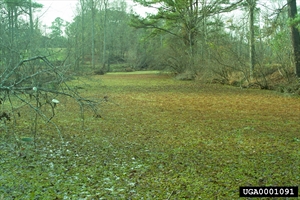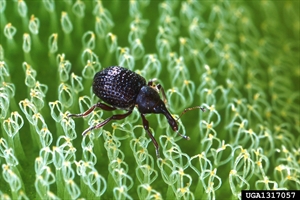Salvinia. CABI prefers the name kariba weed.
Pacific Pests, Pathogens and Weeds - Online edition
Pacific Pests, Pathogens & Weeds
Salvinia (463)
Salvinia molesta. It was previously confused with Salvinia auriculata. It is one of four closely related species; the other species being Salvia herzogii and Salvina biloba. As identification is complicated, because of the similarity of the species, it should be done by specialists. It is a member of the Salviniaceae.
Asia, Africa, North, South and Central America, Europe, Oceania. It is recorded from Australia, Fiji, French Polynesia, New Caledonia. New Zealand, Papua New Guinea, and Vanuatu.
A native of south-eastern Brazil. Naturalised populations occur throughout the world.
Salvinia is a weed of the tropics and sub-tropics, invasive in aquatic habitats, including lakes, rivers, streams, and rice paddies. It thrives in slow-moving, nutrient-rich, warm freshwater, doubling in under 10 days, and forming dense, floating mats that reduce water-flow and lower light and oxygen levels in the water (Photo 1).
Salvinia is a free-floating, vegetatively-reproducing, aquatic fern. It has horizontal stems (rhizomes) just below the water. The shape and size of leaves vary with age and the amount of crowding. In open water, young plants form from a bud at each node along the stem. Leaves (fronds), small, flat, green or yellowish-green, 20-60 mm long and 10-15 mm wide, (the first growth form) (Photo 2). The upper surface are covered in hairs which aid buoyancy (Photo 3). One of the leaves is modified to form feathery roots and remains submerged (Photo 2). As the plants get older, and the density of plants increases, larger leaves are produced that are slightly folded and borne closer together along the stems (the second growth form). Eventually the leaves become very folded and are compactly arranged along the stems (the third growth form) (Photo 4). Sterile spore sacs covered in hairs are produced on the root-like fronds, and hang beneath the water surface (Photo 2).
Spread is by movement of plants and plant parts by wind and water, flood, on the fur of animals, and the clothing of humans. The stems break apart readily and the plants can quickly form new dense mats of foliage on the water surface. Long distance spread can occur in mud on vehicles and the bottoms of boats. However, greatest spread is, perhaps, associated with the dumping of aquatic garden waste, and with the international trade in aquarium plants.
Based on the environmental, economic and human health impacts, salvinia ranks a close second behind water hyacinth in terms of the world's worse weeds (see Fact Sheet no. 455). The stagnant dark environment that it causes as its mats, up to a metre thick, cover the water affects the biodiversity and abundance of freshwater species, including fish and submerged aquatic plants. It also prevents water-based transport and clogs irrigation and power-generating systems. The dense mats have also been reported to harbour larvae of mosquitoes that carry pathogens causing human diseases. They are also a habitat for snails that harbour the trematode, Schistosoma species.
The weed has been used as a compost and mulch, and as additions to livestock feeds.
BIOSECURITY
The risk of introduction is high. Countries not yet infested should consider all likely pathways for entry, and apply quarantine measures accordingly. Particular attention should be given to the risks associated with the trade in salvinia as an aquarium plant. It is readily available via the internet. In many countries, salvinia is a restricted invasive plant under biosecurity acts. In some parts of Australia, this means - a person must not release these invasive plants into the environment, give away or sell as a plant or something infested with its seeds.
Salvinia molesta is among 100 of the World's Worst Invasive Alien Species compiled by the Global Invasive Species Database, maintained by the IUCN Invasive Species Specialist Group, 2020.
BIOCONTROL
There have been spectacular successes with the weevil, Cyrtobagous salviniae, in Australia, Papua New Guinea, in parts of Africa, and elsewhere. Cyrtobagous singularis is similar (Photo 5). In some, it was necessary to manipulate nitrogen levels in the plant to those favourable to the weevils. Two other potential biocontrol agents are a moth, Samea multiplicalis, and a grasshopper, Paulinia acumiinata. The latter is not confined to salvinia: it also feeds on water lettuce and Azolla sp. Samea multiplicalis has given mixed results in Australia: it caused severe damage, but salvinia continued to grow. In the USA, however, where the moth is native, it damaged the related Salvina minima, when released together with Cyrtobagous salviniae.
The experience in Australia is that biological control is indispensable for the management of this pest (See Salvinia control manual, NSW Department of Primary Industries).
CULTURAL CONTROL
- Physical & Mechanical
- Manual removal, but there are obvious disadvantages where the weed exists over large areas. It will depend on the cost of labour; mostly, only practical in the early stages of an infestation before a deep mat of weed occurs.
- Mechanical removal is possible, but probably not competitive in cost with control using herbicides.
- Floating booms. Although it is possible to restrain moderate infestations, those that are large can break the equipment. Costs are high.
- Water nutrient levels. Nutrient levels, especially nitrogen and phosphorous, should be monitored. It is important to prevent sewage entering waterways, as well as the run-off from agricultural lands. High nutrient levels promote rapid growth of salvinia.
- Hygiene
- Treat vehicles, mechanical harvester (and boats) if going from infested to non-infested waterways; wash to remove mud with plant debris.
CHEMICAL CONTROL
In Australia, glyphosate; carfentrazone-ethyl; orange oil, are registered (or under permit) for use against salvinia. In Fiji, MCPA.
--------------------
Note, in the EU, and approval to use glyphosate ends in December 2022; its use after that date is under discussion.
____________________
When using a pesticide, always wear protective clothing and follow the instructions on the product label, such as dosage, timing of application, and pre-harvest interval. Recommendations will vary with the crop and system of cultivation. Expert advice on the most appropriate herbicides to use should always be sought from local agricultural authorities.
AUTHORS Grahame Jackson & Aradhana Deesh
Adapted from Salvinia (Salvina molesta) (2018) Weeds of SE Qld and Northern NSW. Lucidcentral. (https://www.lucidcentral.org/editors-pick-animal-and-plant-identification-keys/key-to-weeds-of-se-qld-and-northern-nsw); and additional information from CABI (2019) Salvinia molesta (kariba weed). Invasive Species Compendium. (https://www.cabi.org/isc/datasheet/48447); and Waterhouse DF, Norris KR (1987) Salvinia molesta mitchell. Biological Control Pacific Prospects. Inkata Press, Melbourne; and Weeds of national significance (2006) Management and control options for salvinia (Salvinia molesta) in Australia. NSW Department of Primary Industries. Published by The State of New South Wales.(https://www.dpi.nsw.gov.au/__data/assets/pdf_file/0008/425807/Salvinia-biological-control-field-guide.pdf); and from Ensbey R (2010) Salvinia. Primefact. Department of Primary Industries, NSW Government. (http://www.dpi.nsw.gov.au/__data/assets/pdf_file/0006/81789/Salvinia.pdf). Photo 1 Scott Robinson, Georgia Department of Natural Resources, Bugwood.org. Photo 2 Leslie J. Mehrhoff, University of Connecticut, Bugwood.org. Photo 3 Troy Evans, Great Smoky Mountains National Park, Bugwood.org. Photo 4 Barry Rice, sarracenia.com, Bugwood.org. Photo 5 Scott Bauer, USDA Agricultural Research Service, Bugwood.org.
Produced with support from the Australian Centre for International Agricultural Research under project HORT/2016/185: Responding to emerging pest and disease threats to horticulture in the Pacific islands, implemented by the University of Queensland, in association with the Pacific Community and Koronivia Research Station, Ministry of Agriculture, Fiji.








